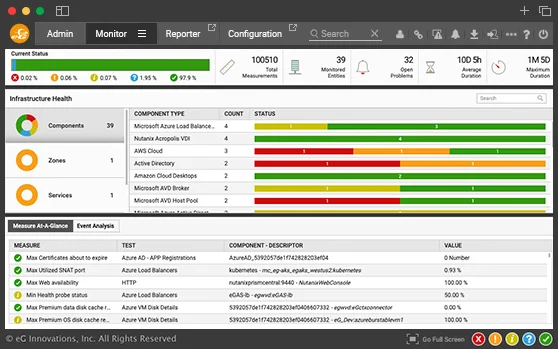Web Server Performance Monitoring and Analytics
Ensure web application performance by monitoring Microsoft IIS, Apache, and Nginx web servers. Track performance and usage by web sites and transactions, error URLs, traffic, queues, slow requests and more.
Free TrialWeb Server Monitoring
These days, a majority of applications are web-based. Web servers play a pivotal role in such environments as they handle all user requests. Any slowdown in the web server tier will adversely affect the user experience.
eG Enterprise provides real-time monitoring, diagnosis and reporting for heterogeneous web server farms. Using a combination of active and passive monitoring, eG Enterprise tracks the availability and performance of the web applications and pin-points where performance bottlenecks lie: in the web server, middleware, database, virtualization platform, storage, etc.
Challenges
IT infrastructures have multiple, heterogeneous and multi-tiered web applications. While multi-tier applications are scalable, they have inter-dependencies between different tiers that make problem diagnosis more difficult. E.g., a problem in the middleware or database tiers causes a slowdown of the entire application and users complain that “the web application is slow”. Multiple web applications hosted on the same web server further accentuate the problem. Excessive load on one application can affect another.
IT managers need a web server monitor that provides visibility into every aspect of performance in order to monitor, diagnose and fix performance issues proactively.
eG Innovations delivers a robust, reliable and extremely valuable solution to deliver maximum uptime and user satisfaction. Pre-emptive alerting helps us to address performance issues immediately before they affect system and application availability.
![]()
Comprehensive Web Server Monitoring,
Diagnosis and Reporting
eG Enterprise provides unified monitoring of all network devices from one console, enables problems to be clearly demarcatedand alerts to be proactively triggered of problems well before users notice.
What eG Enterprise for Web Servers Reveals
| Status of each web site | Traffic breakdown by web site | Errors by web site |
| Response time of key transactions | Workload for key transactions | Web server threads busy |
| CPU usage by server processes | Response time by location | Response time breakup to identify bottlenecks |
| Key server sizing metrics | Application pool status | TCP/IP performance |














